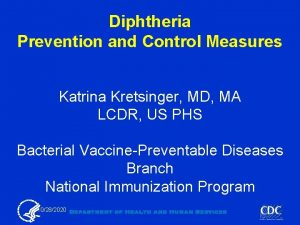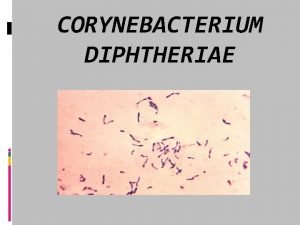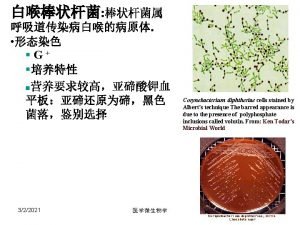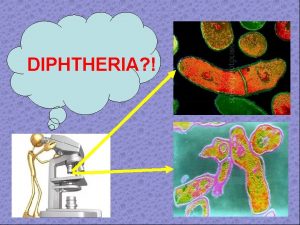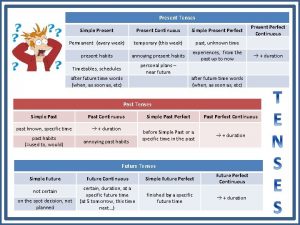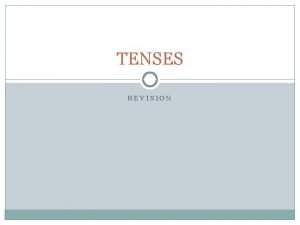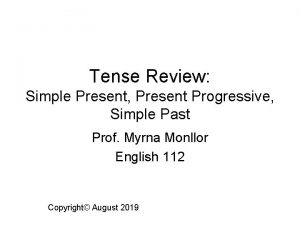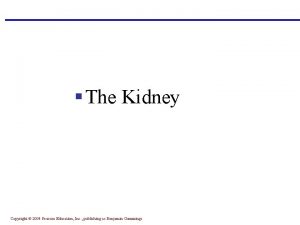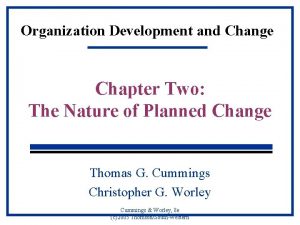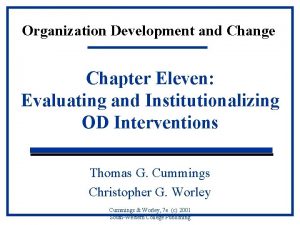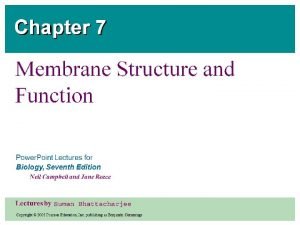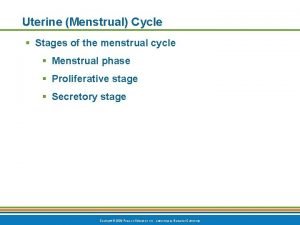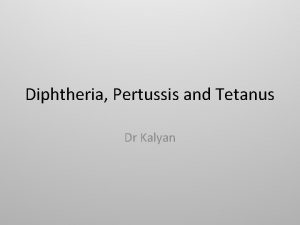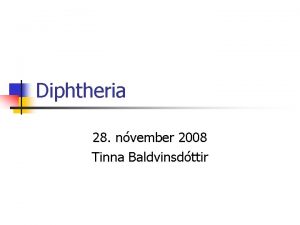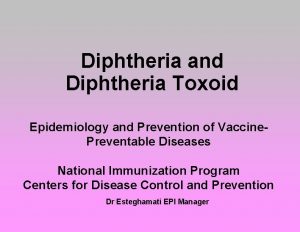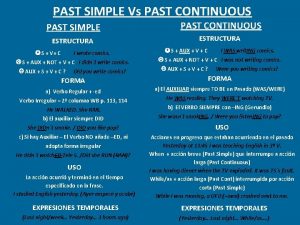DIPHTHERIA The Past Present the Future Dr Cummings




















































































- Slides: 84

DIPHTHERIA The Past, Present & the Future Dr Cummings Henry Consultant Paediatrician DELSUTH

PRE TEST 1. Diphtheria has been eradicated 2. The is a resurgence of diphtheria 3. The mainstay of treatment is antibiotics 4. Vaccination remain the most effective control measure.

The Past Outline n The Present n The future n

n n n Diphtheria, The Past: Introduction Epidemiology Aetio-pathogenesis Immunology Clinical Presentation Complications Differentials Investigations Treatment Prognosis Prevention

Introduction n n An ancient disease described by Hippocrates in the 5 th century BC Plagued Europe & the American colonies in the 18 th century Diphtheria is an acute toxic infectious disease A localized infection of mucous membrane &/or skin May have systemic complications/manifestations

n n Epidemiology Reservoir - Exclusively in humans - Skin infection and skin carriage constitute silent reservoir Mode of spread * primarily by airborne respiratory droplets * direct contact with; -respiratory secretions of infected individuals -exudates from infected skin lesions

Epidemiology contd. In the U. S - Pre-vaccination era(1920 s) > 115, 000 cases and 10, 000 deaths reported annually - Recently, < 5 cases are reported annually n In Nigeria - 5, 039 cases reported in 1989 - 3, 995 cases in 2000 - 2, 468 cases in 2001 - 312 cases in 2006 (7. 8% of global report) n


Epidemiology contd. n n Carriers are important in transmission constitute 3 -5% of healthy individuals in endemic region Estimated mortality rates→ 5 -10% (up to 20% in <5 yrs, & > 40 yrs)

Epidemiology contd. n n Sex No significant difference in the incidence in males & females of similar immunization status Age - Commoner in 6 month-12 yrs (esp. in the pre-vaccination era)

Risk factors Incomplete or absent immunization n Low herd immunity n Travel to endemic areas or regions with current epidemic n Immunocompromised states e. g. HIV/AIDS n Low socio-economic status n Poor health care facilities n Overcrowding n

Aetio-pathogenesis Caused by toxigenic Corynebacterium diphtheriae n Types - Corynebacterium diphtheriae * mitis * intermedius * belfanti * gravis - Corynebacterium ulcerans- causes cutaneous disease n

Characteristics Gram positive n Club-shaped bacillus n Aerobic n Non-motile n Non-encapsulated n About 2 -4μm in length n Assume L &/or V configuration to each other n Form a Chinese lettering pattern n

Corynebacterium diphtheria

Corynebacterium diphtheria n Gram stain n Methylene blue stain

Virulence n n n Depends on the ability to produce the diphtheria toxin-an exotoxin Toxigenicity depends on the presence of a lysogenic bacteriophage Non-toxigenic strain can become toxigenic by coming in contact with toxigenic strains

B-phage that carries the tox gene that encodes the diphtheria toxin

The Exotoxin n n A 62, 000 dalton polypeptide Composed of 2 joined major segments (A and B)

Actions of the Toxin n Segment B bind receptors on susceptible cells and facilitate entrance of segment A Segment A mediates toxic actions: - inactivates RNA translocase - inhibits protein synthesis - causing tissue necrosis n

Actions of The Toxin contd. n Formation of pseudomembrane * a dense necrotic coagulum of organism, epithelial cells, fibrin, leucocytes & RBCs * grayish-white or brown in colour

The Pseudomembrane n Histological n Gross

Other effects of the toxin Paralysis of palate & hypopharynx n Systemic absorption: - renal tubules necrosis - thrombocytopenia - cardiomyopathy - demyelination of nerves - paralysis of the diaphragm n The toxin is converted to toxoid (for vaccination) when treated with formalin n

Immunology n Organisms invasion usually remain localized The main immune response is to the exotoxin n Immune response is antibody-mediated n The antibody is of the Ig. G type – Antitoxin n n Immunity does not prevent colonization rather it protects against the effects of the toxin

Immunology Contd. Active antibodies production may be induced by: - active disease - carrier state - vaccination with the toxoid n Passive immunity –transplacentally transferred n Immunity was previously thought to be life long n

Assessment of immunity n The Schick test: - Intradermal injection of 0. 1 ml 1: 50 dilution of toxin - positive result: inflammation appearing after 24 -36 hrs & persisting for ≥ 4 days – no antitoxin – no immunity - negative result – has antitoxin - immune

Immunity assessment contd. n Assay of serum level of antitoxin - full protection: ≥ 0. 1 IU/m. L - basic protection: ≥ 0. 01 - <0. 1 IU/m. L - no protection : < 0. 01 IU/m. L N. B: Epidemic outbreak is likely when > 90% of the population has < 0. 01 IU/m. L of antitoxin

Clinical Presentation n Incubation: usually 2 -4 days with a range of 1 -7 days n Classified into: - Respiratory Tract Diphtheria - Non-Respiratory Tract disease - Complicated disease

Respiratory tract diphtheria n Nasal Diphtheria - commoner in infants - little or no constitutional symptoms - serosanguineous nasal discharge - epistaxis

Nasal Diphtheria contd. - - purulent foul smelling discharge - shallow ulcers +/- pseudomembrane - unilateral or bilateral - may persist for several weeks - major source of transmission

Tonsilo-Pharyngeal Most common (90% of cases) n Malaise n Fever – mild to moderate n Sore throat – drooling, odynophagia +/dysphagia n Bull-neck appearance n Pseudomembrane of variable extent n

Bull-Neck appearance

Pseudomenbrane

Laryngeal Diphtheria n Usually an extension of pharyngeal disease n Hoarseness of voice n Cough n Inspiratory stridor

Laryngeal Diphtheria contd. n n Suprasternal, substernal & subcostal recessions Symptoms & signs of sudden airway obstruction n Sudden death n May require intubation/tracheotomy

Tracheo-bronchial diphtheria n Usually an extension from pharynx & larynx n Diphtheria pneumonia – hemorrhagic n Bronchiolar pseudomembrane n Airway obstruction/sudden death

Diphtheria Pneumonia

Non-Respiratory disease

Cutaneous diphtheria

Cutaneous diphtheria superficial, non-healing ulcers n well defined margins n pseudomembrane on floor of ulcer n erythema & tenderness of surrounding skin n important in transmission in the community n

Cutaneous diphtheria contd. Predisposing factors: - pre-existing dermatoses - laceration - burns - bites - impetigo n

Other non-respiratory disease Ear- otitis externa n Eye – purulent and ulcerative conjunctivitis n Genital tract – purulent and ulcerative vulvo-vaginitis n Rarely septicaemia n

Complications n Toxic Cardiomyopathy - commonly myocarditis, rarely endocarditis - usually occurs at the end of 2 nd wk of illness - tachycardia out of proportion to fever - arrhythmias - symptoms & signs of CCF - occurs in 10 -25% of patients - accounts for 50 -60% of deaths

Toxic Cardiomyopathy contd. n n ECG findings: - prolonged PR interval - ST segment elevation - 1 st, 2 nd, or 3 rd degree heart block Echocardiogram: - dilated cardiomyopathy - hypertrophic cardiomyopathy - vegetations

Toxic Neuropathy n Usually occurs at 3 -4 wks n Affects mainly motor functions n Paralysis of soft palate &pharyngeal wall - nasal voice - difficulty in swallowing (esp. fluids)

Toxic Neuropathy contd. n n n Occulomotor N. & cillary paralysis - strabismus &/or blurred vision Peripheral neuritis – diminished DTR & paralysis - occasionally glove & stockings neuropathy ( like GBS) Paralysis of the diaphragm

Airway obstruction n Commoner in laryngeal disease n May be sudden n n Usually due to dislodgement of Pseudomembrane May require intubation/tracheotomy & mechanical ventilation

Differentials Tonsillo-Pharyngitis n Viral Croup n Epiglottitis n Peritonsilar abscess n Angioedema n Myocarditis (other causes) n Peripheral neuropathy 2 o GBS n

Laboratory Studies n Methylene blue &/or gram staining n Culture using tellurite-Loeffler media n Toxigenicity test: - Elek test - PCR

Laboratory studies contd. n FBC – moderate leucocytosis n Urinalysis – transient proteinuria n Serum assay of antibodies – immunity n Serum assay of troponin 1 – myocarditis

Radiological studies Echocardiogram & ECG findings n Neck soft tissue X-ray – prevertebral soft tissue swelling: n

Treatment n Diphtheria Antitoxin - mainstay of treatment - give at clinical diagnosis - can only neutralize free toxins - efficacy diminishes with delay - only available from CDC/WHO - preferably given IV - dosage depends on site involved & duration of illness

Dosage of Antitoxin (units) n n n n n • Site and extent of lesion Nasal One tonsil Both tonsils+/Pharyngeal Laryngeal or Combined types Very extensive Disease illness<72 hrs 10, 000 -20, 000 illness >72 hrs 10, 000 -20, 000 -40, 000 -60, 000 40, 000 -80, 000 60, 000 -80, 000 -100, 000 N. B. Test for sensitivity before administration and desensitized if necessary

Testing for Sensitivity Skin test: - Intradermal injection of 0. 1 m. L of 1: 10 dilution of antiserum in saline - read in 20 mins - a wheal ≥ 1 cm – positive – sensitive n Conjunctiva test: - conjunctivitis & lacrimation – positive n Caution! Ensure adrenalin is available n

Desensitizing n n n 0. 1 ml of a 1: 20 dilution subcut. 0. 1 ml of a 1: 10 dilution subcut. 0. 1 ml undiluted subcut. 0. 3 ml undiluted IM 0. 5 ml undiluted IM - wait 20 mins wait 20 mins If no reaction has occurred the rest of the dose can be given IM

Antimicrobial therapy Role: - halt toxin production - treat localized infection - prevent transmission n Drugs/dosage - IV/IM penicillin * iv xtapen 100, 000/kg/day in 6 hrly dosing * im procaine pen. 25, 000 iu/kg/day, 12 hrly - Oral erythromycin, 40 mg/kg/day 6 hrly n

Antimicrobial contd. n n n Other drugs that can be used: - Clindamycin - Tetracycline Give for 10 – 14 days Elimination of organism should be confirmed by at least 2 successive negative culture obtained 24 hrs apart.

Treatment contd. Isolation - respiratory isolation for respiratory disease - contact isolation for cutaneous disease n n Bed rest n Secure airway if necessary n NG tube feeding – palatal/pharyngeal paralysis

Treatment contd. n IV fluid administration if needed n Vaccinate – 10 series &/or boosters n Disease notification n Contact tracing

Contact tracing & Care n n n The risk of developing the disease after household exposure to a case is ≈ 2% The risk of disease after exposure to a carrier is ≈ 0. 3% Types of contacts: - asymptomatic case contact - carrier

Asymptomatic case contact monitor for illness n culture n Antimicrobial prophylaxis n Vaccinate nprimary schedule. nbooster dose n

Carrier n The reported rate of carriage in household contacts of case patients is 0 -25% Antimicrobial prophylaxis x 7 days n Isolation n Monitor n Vaccination n

Prognosis Depends on: n Virulence of the organism. Gravis has the highest fatality followed by intermedius and the least is mitis. n Age; higher mortality rates in individuals < 5 yrs and those > 40 yrs. n Immunization status: worse in the unimmunized

n n Prognosis (contd. ) Site of infection/involvement; mortality occur in: n < 1% of cutaneous disease n ≈ 10% of uncomplicated respiratory disease n 30 – 40% of bacteremic disease n 60 - 90% of those with cardiac involvement. Speed of administration of antitoxin; worse with delay

Prevention n Immunization is the mainstay of prevention n Given as DPT n Immunization schedule (NPI) - DPT 1 – 6 wks - DPT 2 – 10 wks - DPT 3 – 14 wks

The Present

Emerging Issues n Changing epidemiology - recent re-emergence in some developed and developing countries - Shifting of the disease into the older population


n Immunity wanes over time


Other Epidemiological issues n Questionable Notification from Nigeria Erratic values: - In 1996 reported 2016 cases - In 1997 , , 31 cases *DPT 3 coverage in 1996 – 30%

Inconsistent figures n In 2003 & 2004 – no case reported * In 2003 Nigeria had the worst immunization coverage in the world DPT 1 coverage – 43. 2% DPT 3 coverage – 24. 8% Only 12. 8% were fully immunized

Latest Immunization Coverage n n n Global: 79% estimated DPT 3 coverage Current coverage in Nigeria: - DPT 1 is ≈ 65% - DPT 3 is ≈ 77% WHO proposed coverage is ≥ 90%



Changes In Immunization strategies n n Effect of passive immunity on 10 series Commencing 1 O series later e. g. - In the US DPT 1 – 2 mth DPT 2 – 4 mth DPT 2 – 6 mth

New Immunization Strategies contd. n Boosters: - Given at *18 mths *5 yrs *adolescence *every 10 yrs thereafter


New Formulations of the Toxoid Td - tetanus toxoid with lower dose of diphtheria toxoid - adult type *for adolescence & beyond - less side effects n Tdap - tetanus toxoid + smaller dose diphtheria + acellular pertusis vaccine - may be used for pregnant women n

Other Emerging Issues n Antitoxin for Carriers: * To give or not to give ? n The need for vaccination of pregnant women

The Future

Recommendations n n n Improve coverage of 10 schedule to 90% at least 4 th & 5 th DPT doses at 18 mths & 5 yrs respectively Improve disease Surveillance and notification

Recommendations contd. n Research to evaluate the need to - delay commencement of the primary series - give booster doses at adolescence & thereafter every 10 yrs, using Td - give Td or Tdap to pregnant women

Conclusion n The global goal is to eradicate diphtheria. This may only be achieved by not only making the right policies but also ensuring that these policies are completely and effectively implemented.

THANK YOU
 Dr frank kretsinger
Dr frank kretsinger Corynebacterium diphtheriae
Corynebacterium diphtheriae Bull neck appearance
Bull neck appearance Diphtheria cdc
Diphtheria cdc Diphtheria
Diphtheria Present past future simple exercises
Present past future simple exercises Simple past simple present simple future
Simple past simple present simple future Present simple past simple future simple present continuous
Present simple past simple future simple present continuous Present simple and future simple
Present simple and future simple Future perfect or future continuous
Future perfect or future continuous Future continuous and future perfect
Future continuous and future perfect Past simple past continuous past perfect present perfect
Past simple past continuous past perfect present perfect Tense chart for 6th class
Tense chart for 6th class Present simple past simple future simple
Present simple past simple future simple Parallel action in the future
Parallel action in the future Example of past present and future tense
Example of past present and future tense Past and future tense verbs
Past and future tense verbs Present tense in afrikaans examples
Present tense in afrikaans examples Future progressive tense of sleep
Future progressive tense of sleep Verbo to be present perfect
Verbo to be present perfect Been past participle
Been past participle Future simple examples
Future simple examples Haber past
Haber past Past present future in japanese
Past present future in japanese Action verbs past present future tense
Action verbs past present future tense List of helping verbs
List of helping verbs Unit 1 present tenses
Unit 1 present tenses Me past tense
Me past tense Draw past present future tense
Draw past present future tense Past present future
Past present future Jesus past present future
Jesus past present future Celebrar preterite
Celebrar preterite Past present future triangles
Past present future triangles Future tense of verb
Future tense of verb Future tense
Future tense Get present perfect
Get present perfect Future perfect tense
Future perfect tense Verbo to play
Verbo to play Present simple past simple future simple
Present simple past simple future simple E marketing past present and future
E marketing past present and future Simple present for timetables
Simple present for timetables Passive present perfect
Passive present perfect Passive of present perfect continuous
Passive of present perfect continuous Passive of present continuous present perfect future
Passive of present continuous present perfect future Affirmative past progressive
Affirmative past progressive Past perfect y past simple ejemplos
Past perfect y past simple ejemplos Past simple past perfect past continuous exercises
Past simple past perfect past continuous exercises Past simple past continuous past perfect таблица
Past simple past continuous past perfect таблица Narrative tenses past continuous
Narrative tenses past continuous Past continuous vs past perfect
Past continuous vs past perfect Past continuous vs past perfect continuous
Past continuous vs past perfect continuous Narrative tenses
Narrative tenses Past simple past continuous exercises word
Past simple past continuous exercises word Present progressive form
Present progressive form Present perfect present perfect continuous past simple
Present perfect present perfect continuous past simple Past tense
Past tense Tear in the past
Tear in the past Past present progressive
Past present progressive If tenses
If tenses Past simple present perfect present perfect continuous
Past simple present perfect present perfect continuous Past simple en present perfect
Past simple en present perfect Passive gradjenje
Passive gradjenje Present continuous function
Present continuous function Present simple present continuous past simple
Present simple present continuous past simple Present simple present continuous past simple
Present simple present continuous past simple Simple present tense review
Simple present tense review Present perfet
Present perfet Present perfect vs present progressive
Present perfect vs present progressive Present simple present progressive past simple
Present simple present progressive past simple Present simple present progressive past simple
Present simple present progressive past simple Pearson education
Pearson education The furthest distance ive travelled poem
The furthest distance ive travelled poem Cummings and worley change model
Cummings and worley change model Ee cummings love is more thicker
Ee cummings love is more thicker Alma cummings dance marathon
Alma cummings dance marathon Ivor cummings
Ivor cummings When was the first pinball machine invented
When was the first pinball machine invented Cummins
Cummins Buffalo bill ee cummings
Buffalo bill ee cummings Iowa voc rehab
Iowa voc rehab Clint cummings
Clint cummings Cummings
Cummings Pearson education inc publishing as benjamin cummings
Pearson education inc publishing as benjamin cummings Cummings
Cummings Ovarian cycle
Ovarian cycle
